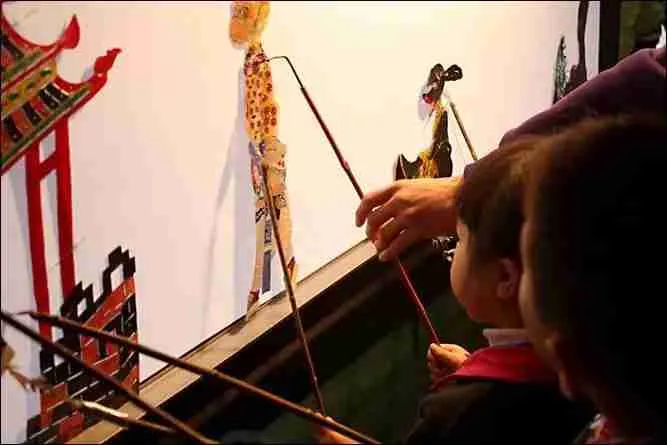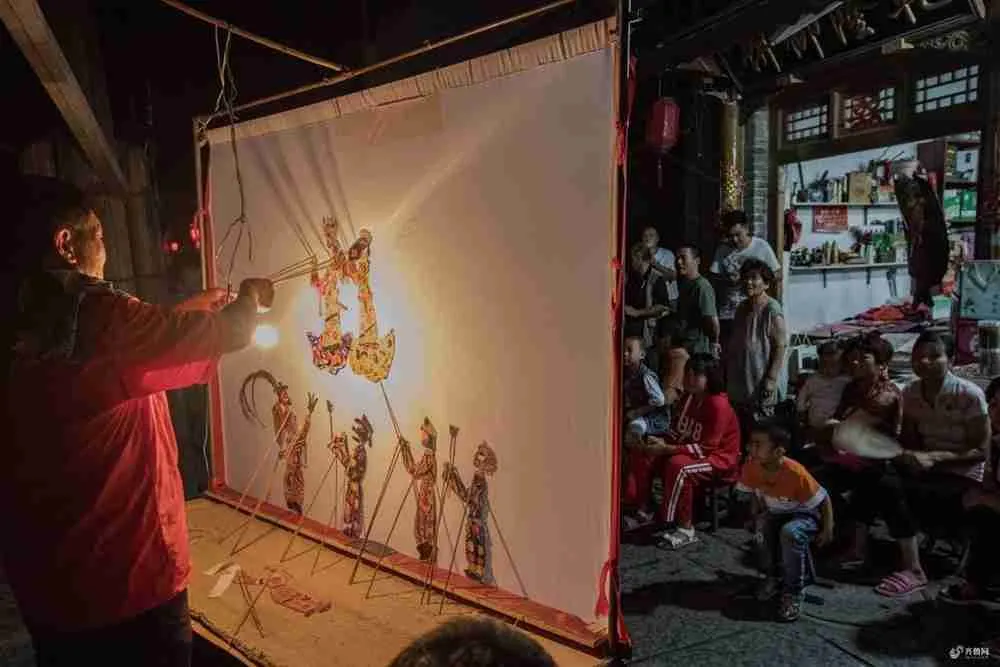One of the prominent things that stands out from Chinese culture is their art forms and the fact that even their oldest traditions live on to date. One such cultural element that makes the Chinese very fascinating is Chinese shadow puppetry. This is an elaborate art creation that depicts some of the most influential elements of the Chinese people and societies.
If you are planning a trip to China and you would like to experience the very best that the Chinese have to offer, aside from the food, you may want to attend a Chinese shadow puppetry show.
In this article, we’ll share all you need to know about Chinese shadow puppetry and why it is a big deal.
Shadow Play Meaning/Shadow Play Definition

Chinese shadow puppetry, also called Shadow Play or palace performance, can be defined as one of the remarkable theatrical art performances common in China, involving the use of the shadows of puppets that are cast on a large screen. Throughout China, the shadow puppets used are semi-transparent leather plates with semi-transparent dyes applied to them, resulting in shadows that are cast on the screen. The result of the shadows cast is colorful, and this is what results in the most colorful and animated screen performances.
This type of theatre performance features acting with colorful silhouettes and figurines that are made of paper or leather. And to make the performances more lively, the shows are accompanied by singing and music.
The silhouettes that make up the show are manipulated by skilled puppeteers by the use of rods, resulting in the figures giving off an illusion of moving images moving on the translucent screen made of cloth and is illuminated from the back. It’s interesting to note that despite the Shadow Plays being practiced for many years, most of the artists for Shadow Play are elderly, but they can still perform well, showing off dozens of the traditional Chinese plays that are either transmitted by word of mouth or available in written form. To do all that, these artists have great skills, and they have also mastered the special techniques needed for the best performances. These techniques include falsetto, improvisational singing, as well as the simultaneous manipulation of multiple puppets at the same time while also playing several musical instruments at the same time. The master puppeteers are also skilled in carving out the puppets, which is no mean feat given the fact that some of these puppets have between 12 and 24 movable joints.
In most cases, however, shadow plays and shows are performances that feature large troupes of between 7 and 9 performers. Some have smaller troupes, though, and these often have 2-5 performers. The smaller plays are often seen in religious rituals and small entertainment events/ needs like funerals and weddings, among others. The main musical instruments used include flutes, drums, horns, and gongs.
The level of skill and experience differ as well, and some plays feature professionals, while others are mostly made of amateurs.
So, why is the Chinese Shadow Puppetry such a big deal? Well, this art form is an important part of the Chinese culture, and the thing that makes it stand out from other things and professions of today is the fact that the relevant skills needed for puppeteering are passed down families, in the troupes, and also from the master to the pupil such that there is always a group of people that run the puppeteering shows exclusively.
On top of this, Chinese Shadow Play offers an incredible way for the Chinese people to share ancient tales, pass down information about ancient Chinese cultural history, as well as traditions, social beliefs, and the local customs that make for the richness of the Chinese people.
There is also the fact that these shows spread a great deal of knowledge, it is entertaining to the community, and also promote cultural values.
So, where and when did the Chinese Shadow puppetry start?
Shadow Play History
Chinese Shadow Play is believed to have originated from the time when the Tang and Song dynasties ruled China. This was between 618 and 907 and then between 960 and 1279, respectively. During this time, the shadow puppets were made of paper sculptures, and it wasn’t until many years later that they started using leather from oxen and donkeys – this is also where the name pi Ying or shadows of leather originated from.
In other words, Shadow Puppetry started at least 2,000 years ago. It is believed that it started when Han Dynasty’s Emperor Wu’s most favorite concubine passed away after falling ill. After the loss, the emperor was devastated, and he missed her so much. The grief affected his ability to rule, and he not only ignored important affairs of the state but also went on to order his officials of the court to bring her back to life.
One day, one of the emperor’s ministers saw children playing with dolls, and the shadows cast on the ground by the dolls were very vivid. This scene inspired him and gave the minister an idea – the minister came up with a cotton puppet that looked like the concubine, then he painted it. This reshaped puppet was made of donkey’s skin and the joints used were animated with 11 pieces of separated leather pieces. The painting of the puppets was necessary to complement her beauty. After nightfall, the minister invited the emperor to watch his performance in which he had a rear, oil lamp-illuminated show behind the curtain, featuring the painted puppet whose shadow moved behind the curtain to depict the emperor’s beloved, and to show that they had somehow brought her back to life. This delighted the emperor and somehow brought him back to life, and he took to watching these puppet shows from time to time.
This story has been recorded in the official Chinese history book – The History of the Han Dynasty, and it is believed to be the real origin of Shadow puppetry.
After the performance, the shadow plays grew popular, reaching peak performance during Song Dynasty’s reign. And by the time the Ming Dynasty ruled, there existed 40-50 troupes for shadow play based in Beijing alone.
And during the Yuan Dynasty’s reign towards the end of the 13thcentury, the puppet shows had been transformed into one of the main forms of entertainment, with the Mongolian troops enjoying the performance each night at the barracks. As the Mongols swept across the continent, conquering Asia, Shadow plays spread further and became very popular even in distant countries like Arabia, Persia (Iran), and even Turkey.
It’s noted that thanks to the high-profile origins of this art form, shadow play was later on adopted as a form of entertainment by civilians. Shadow puppetry was a big deal during Tang Dynasty’s reign between 618 and 907, and it was later introduced to European countries and West Asia between 1271 and 1368 by the Yuan Dynasty.
Shadow puppetry, however, reached its heyday during the reign of the Qing Dynasty, 1644- 1912, and shadow play was performed in essentially all the provinces and anywhere from the court to the countryside. In these performances, pretty much all the troupes were equipped with many boxes holding several delicately and well-carved puppets.
Chinese Shadow Puppetry Stories

The emperor Wu’s concubine’s story notwithstanding, most of the stories shared and depicted through the shadow plays were political in nature or were related to politics.
But many other shows were used to share stories about different legends and stories told in the past. Other stories were fairy tales and even epic stories that needed to be shared.
Where Did Shadow Puppets Originate
It is believed that shadow play originated from the Han Dynasty during the reign of Emperor Wu – between 141-87BCE. It was developed by one of the ministers to cheer up the emperor and to bring Lady Li, the emperor’s beloved, ‘back to life’ after she passed away.
How To Make Chinese Shadow Puppets
The Chinese shadow puppets are a tad complicated, with some needing as many as 24 procedures requiring at least 3000 cuts just to produce one figure. The puppets are 2-dimensional, and to make them stand out, the props were elaborate and transparent but made of donkey hide or cowhide.
For the heroes, the puppets had long, narrow eyes and smallmouth along with a straight bridge representing the nose. The villains, on the other hand, have small eyes, a sagging mouth, and a big forehead.
The colors of the puppets are also important, with the use of red masks representing bravery and royalty, while the black masks symbolize uprightness. The white mask represents treachery.
After carving the puppets, they’d be painted with a transparent dye in yellow, red, blue, black, and green for the shadows that are to be cast on the screen. These colors ensured beautiful and elegant shadows. The puppet’s bodies are then adorned with accessories and colorful clothes, which would help to distinguish the puppet’s identity and official status in society. Color saturation is important for maximum visual impact.